On-board equipment for unmanned aircraft systems
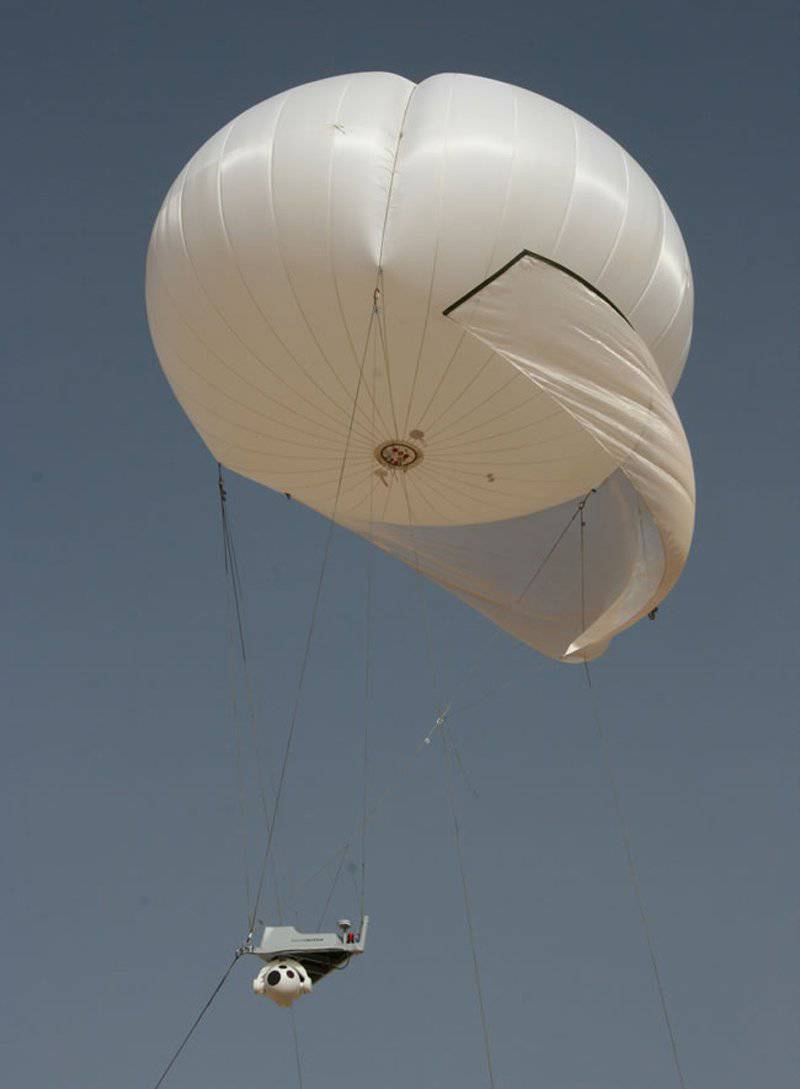
CONTROP SPEED suspended from aerostat for continuous monitoring.
Unmanned aviation complex (LHC) is much more than just an air tool. More and more funds are being invested in the LHC, as they are used to perform an increasing number of tasks, both civilian and military. A variety of on-board hardware make these tasks feasible: sensors, cameras, radars, communications electronics, electronic warfare (EW), weapons, etc. However, the fulfillment of the requirements for mass-dimensional and energy-consuming characteristics causes considerable difficulties. In addition, creating and maintaining real-time data transmission channels and the ability to deliver the right information to the right people at the right time is still a difficult task.
A UAV (unmanned aerial vehicle) is only part of the LHC, consisting of a system of data channels, sensors and support components. The air vehicle itself is perhaps the simplest of the elements of the whole complex. Indeed, this apparent simplicity has already misled many who thought that “the UAV is a radio-controlled model of a green plane with cameras”, which will give them easy access to the lucrative defense market.
The LHC is currently a wide range of instrumentation, which includes optical-electronic (OE) sensors, such as day cameras, infrared cameras, thermal imaging cameras or radars. This may even include radio stations acting as air repeaters. This may be information acquisition equipment or EW, for example, EURO HAWK UAV carrying ELINT equipment of German design. It can also be scientific instruments, atmospheric sensors or lidar (laser locator). It may even be the most common cargo. Indeed, US Marines and special forces experienced unmanned (or optionally manned) rotor drones, such as Kaman K-MAX, a Boeing LITTLE BIRD demonstrator and A-160T HUMMINGBIRD.
However, there is one clear trend linking all these types of ISTAR equipment (information gathering, surveillance, target designation and reconnaissance); Thanks to the ongoing digital revolution, these sensors are now becoming smaller, lighter, and cheaper. For example, the sizes of synthetic aperture radars (PCA) began to rapidly decline, ranging from the large AN / APY-7 system installed on the E-3 JSTARS and further down to the smaller mini-PCA, micro-PCA, and now even pico-PCA devices . For example, an active electronically scanned antenna from Selex Sensors and Airborne Systems weighs less than 10 kg.
Camera systems have also become lighter, more compact and more accessible due to consumer technology, they allow you to get more and more high-quality images from smaller and smaller UAVs. For larger UAVs with greater capacity and payload capabilities also grow. For example, ARGUS-IS (Autonomous Real-Time Ground Ubiquitous Surveillance Imaging System - autonomous reconnaissance system for obtaining images in real time) from BAE Systems is a 1,8 Gigapixel continuous monitoring sensor, consisting of XMUM five-megapixel cameras; it is able to cover a whole city or about 92 km40. It will be located on board the Boeing A-2T UAV.
For larger UAVs, along with sensors, the payload can currently include weapons. This is no longer a new idea, during the Second World War, assault drones The TDR-1 of the US Navy can be considered the first unmanned attack aircraft. The constant and rapid growth of military UAVs in the past decade has led to increased interest in arming such vehicles. Currently, the US and RAF's MQ-9 REAPERS are armed with HELLFIRE missiles and PAVEWAY 500-pound laser-guided bombs, but there is little time left before the integration of additional weapons, such as conventional bombs. Similar to the sensor miniaturization trend, the next generation of UAV weaponry could become even smaller and more accurate. VIPER STRIKE from Northrop Grumman, for example, has a warhead weighing 1,05 kg, which reduces indirect losses in urban areas.
UAVs can also be used to control crowds, counter-terrorism operations and security tasks where non-lethal weapons, such as tear gas, paint, or paintball guns, may be needed.
COMPASS mounted on a HERMES 450 UAV
Vertical Takeoff MQ-8B Fire Scout UAV with Brite STAR II from FLIR System
Images, cameras, sensors
Exceptional vision is the ability to see what others cannot see. This is the ability to see first, to act first, and such capabilities are provided by modern OE / IR (optoelectronic and infrared) imaging devices. They give a decisive advantage.
CONTROP Precision Technologies Ltd specializes in the design and manufacture of electro-optical systems and precise motion control systems. UAV products include stabilized, high-performance visual inspection equipment for day-and-night surveillance. CONTROP has been developing and manufacturing OE / IR equipment since 1993. The company's on-board equipment is gyro-stabilized in two or three axes using 3, 4 or 5 universal joints. The equipment provides high-quality image with high resolution (in a narrow field of view), which does not depend on platform maneuvers and vibration. Image quality is the same with horizontal and vertical camera movement. A wide range of CONTROP equipment includes various products that differ in size, weight and type of OE / IR sensors, as well as their application. CONTROP equipment has a different mass, ranging from 0,75 kg for a miniature stabilized set of STAMP and to 46 kg for a large multitouch kit.
Equipment sets differ in the type of sensors installed in them, including:
- Daytime color 1PZS or 3PZS cameras,
- A black and white surveillance device with a very long focal length,
- Cooled and uncooled thermal imaging cameras (FLIR) with continuous zoom lenses,
- Eye safe laser distance meter (LRF), and
- Laser pointer
CONTROP hardware is suitable for installation, mounting and use on a wide variety of platforms, including:
- Air tools, such as mini-UAVs, aerostats, UAVs, vertical take-off / helicopters, fixed-wing vehicles, etc.,
- ground vehicles, ANA (automatic ground vehicles), poles, masts, etc., and
- sea vehicles, AMA (automatic surface vehicles), ships, boats, hovercraft, etc.
CONTROP equipment is designed for applications that need aerial mapping, including surveillance, reconnaissance, search and rescue operations and other tasks. In addition, equipment with very high performance with a very small mass greatly expands the possibilities for their installation on various vehicles.
CONTROP equipment includes the following groups:
- Short-range equipment for effective ranges to 1000 meters,
- Medium-range equipment for effective ranges to 3-5 km, and
- Long-range equipment for effective ranges to 7-10 km.
According to recent reports, a new optoelectronic station with a laser designator from the CONTROP company has been delivered to a very important buyer based on its most stringent requirements. This LDP is a high-performance, gyro-stabilized EO / IR instrument with a laser target designator, weighing only 32 kg. Being at the forefront of day / night stabilized cameras, the CONTROP's MA / IR equipment has several unique features. A thermal imaging camera with a variable focal length lens makes the CONTROP equipment very “user friendly.” In addition, improved image processing algorithms make it possible to have a high-quality image, even when there is a “hot spot” in the image (explosion, fire, etc.). The characteristic of automatic local gain control is unique for thermal cameras from CONTROP, it provides the ability to see fine details of the image instead of large temperature drops and dark areas in the observed area.
Elbit Systems Electro-Optics - Elop Ltd, a division of Elbit Systems, is a recognized leader in stabilized OE systems. Its systems currently operate on a wide variety of air, sea, and land platforms under the most adverse environmental conditions; however, they meet the stabilization / observation requirements during the execution of the prescribed task. Elop's stabilized OE equipment provides optimum visibility, observation, tracking and targeting even under the most “harsh” conditions. Elop's main monitoring and survey products are: AMPS (Advanced Multi-Sensor Payload System - advanced multi-touch complex), optimized for the entire spectrum of aircraft information collection tasks; CoMPASS (Compact Multi Purpose Advanced Stabilized System - compact universal advanced stabilized system), stabilized multi-sensor OE equipment; DCoMPASS, the newest member of the CoMPASST family, combines modern digital electronics and networking technologies with the high-performance capabilities of the existing CoMPASST family; and Micro CoMPASS - day / night surveillance system.
One of the most exciting advances in OE technology in recent years has been the emergence of low-cost matrices of uncooled IR video converters, having in their composition very small thermoelements or bolometers. The KTL-30 camera complex, developed by the Polish company Etronika, and first presented at IDET 2011 in the Czech city of Brno, provides high-resolution video around the clock and thereby improves situational awareness. At the heart of the tiny camera is an uncooled bolometric array, the 680x480 detector, designed to meet the most demanding requirements of modern military and law enforcement operations. Very good resolution allows you to reliably recognize objects even with a small temperature difference between the object and its environment. The complete device weighs less than 100 grams.
Due to its low weight and low power consumption, the camera is ideally suited for installation on mini-UAVs for advanced navigation, target designation and a large number of images. When deployed for these specific tasks, it also allows ground troops or dismounted combat units to identify, identify and monitor objects on the ground and respond effectively to rapidly changing combat environments even during the “chaos of combat”. With regard to survivability, maneuverability and mortality, such improved capabilities directly and significantly increase the likelihood of successful completion of the task.
Etronika developed the KTL-30 camera system in half a year. It is today the smallest camera manufactured in Poland.
FLIR Systems is the world leader in OE / IR imaging systems. For more than 40 years, FLIR has manufactured all types of IR systems, including air and sea observation and targeting systems, ground and transport combat sensors, scopes and hand-held systems. From RQ-11A / B RAVEN to MQ-8B FIRE SCOUT, FLIR has supplied thousands of sensors and systems for automated applications. Star Class Systems SAFIRE and BRITE Star have the same characteristics as larger systems class 20 inches, but at the same time in a more compact, lightweight and multi-touch configuration. Battle-tested and qualified for the most demanding requirements of MIL-SPEC military standards, these systems have proven reliability and guaranteed logistics around the world. They are distinguished by the latest technical innovations, including high accuracy, targeted geolocation based on the integrated GPS / IMU system (global navigation and positioning system and inertial measurements); diode-pumped laser technology; and second generation Full HD digital imagers. These systems provide a complete set of standard interfaces, they are tested on automatic (unmanned) applications. FLIR also provides a full range of features in the TALON and COBALT families. Creating different configurations in size and weight for installation on all classes of uninhabited platforms, FLIR for each system completes a set of sensors and other devices. All systems are qualified by MIL-SPEC, are available in a single quick-change configuration and have the entire set of interfaces. TALON systems are tested on habitable and uninhabited military applications, while the COBALT family of systems is specifically designed for automatic, uninhabited applications.
Goodrich's Sensors Unlimited working group has developed and manufactures detectors, multicomponent systems, cameras operating in the near-wave region of the IR spectrum, which use advanced indium-gallium-arsenic video converter technology and are used in industry, the military, agriculture and scientific research.
IAI Tamam's family of gyro-stabilized OE kits have been specifically designed to meet the needs of a wide range of applications. While all OE devices provide FLIR-based cameras with high-quality, round-the-clock surveillance, some of them can also provide highly accurate target designation, guidance and tracking. Tamam is the world leader in the delivery of OE-equipment for UAVs and its product line includes:
- MOSP (multi-mission optronic stabilized payload - multitasking optical-electronic stabilized equipment) is a medium-range OE station from Tamam. Having a very good stabilization, the MOSP can be supplied with a wide variety of sensor sets, including a CCD, FLIR (Front View Thermal Imaging System), a laser range finder, a laser designator, a laser pointer, and a tracking device.
- Tamam's small POP OE station is designed to meet the observation requirements for short distances. The POP Kit has been selected for various aircraft, UAVs, helicopters, security systems and gun sights. The basic POP configuration includes CCD and FLIR cameras with optional laser pointer and video tracking.
- The set of stabilized EO-equipment under the designation MINIPOP is a compact round-the-clock surveillance system for military, paramilitary and civilian tasks.
- MicroPOP Kit is the latest light stabilized system of round-the-clock surveillance for tracking tasks at close range. The system provides modern, improved image acquisition capabilities for mini-UAVs.
- CoMPASS from Kollsman, Inc. - is a stabilized high-performance OE surveillance, tracking, and target designation system for combat conditions.
The stabilized cameras, the stabilized Pan Tilt Zoom surveillance systems from MicroPilot, which have interchangeable thermal imaging and day cameras, are fully integrated with the MP2028g or MP2128g autopilot systems and the HORIZONmp ground control software from the same MicroPilot. These systems provide high resolution and sensitivity, have a small mass, built-in diagnostic system and a simplified interface with the UAV.
Micro UAV company supplies a line of cameras on the universal hinge BTC (Ball Turret Camera), which are designed for the latest generation of ultra-light miniature UAVs. Guidance can be performed manually or at the expense of the autopilot guided by GPS signals, giving the position in space and the height of the vehicle, which allows you to point the camera at any GPS coordinates and save this position if desired. Standard cameras operate with pulse code servo mode and can be easily installed using the “plug and play” principle.
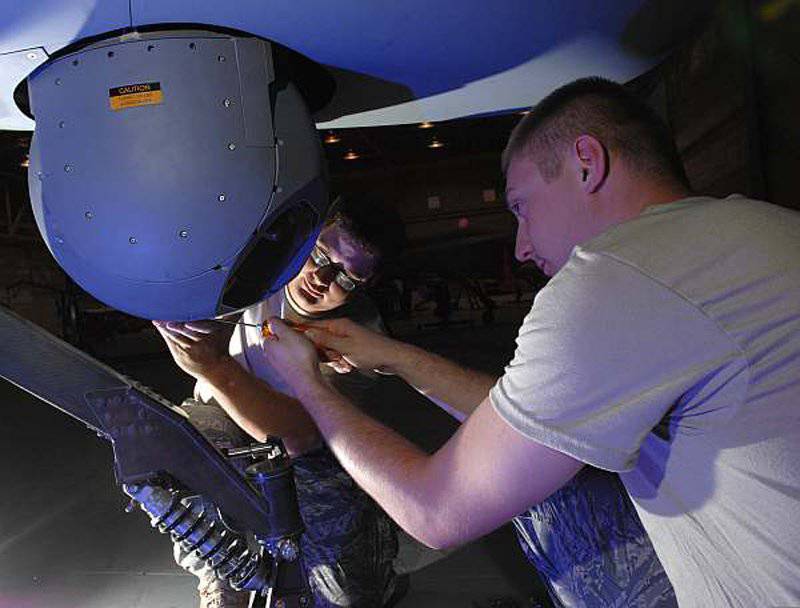
Contrary to the same optimistic expectations, large UAVs and their highly complex onboard equipment actually require at least the same amount of service as manned vehicles. In the photo, avionics specialists from the 163-serving unit, checking the optical-electronic station installed on the MQ-1 PREDATOR UAV
Rafael Advanced Defense Systems Ltd’s RECCELITE is an autonomous, self-cooling multi-touch reconnaissance system consisting of an onboard container, a broadband digital data channel and a ground control station. Operational flexibility is provided by the following features: simultaneous collection of high-resolution images in the IR spectrum, in the visible and near IR spectrum day and night; equipment in the gimbal suspension provides stable photographing, regardless of the UAV maneuvers and deviations from the flight route; unlimited viewing area and various scanning modes for optimal photographing of all types of terrain; accurate coverage and high quality images; and task scheduling, either automatically or manually to track random targets.
Rafael's RECCE-U is a reconnaissance and real-time data acquisition system for UAVs based on the RECCELITE system. The RECCE-U system has an identical infrastructure with RECCELITE, for example, it is geolocation, a data transmission channel, quick-detachable units and serving capacities. Automatic image processing allows it to be interpreted by humans and provides seamless editing, referencing the terrain, detecting changes, stereo image, superresolution, etc.
Saab offers electronic surveillance equipment (ESP), created as a standalone electronic intelligence system that integrates with a UAV, based on a radiation source direction finding system (ELS) manufactured by Saab Avitronics and has an increased probability of interception for search radar.
Optical Alchemy sensory systems are designed for reconnaissance, surveillance, target detection, situational awareness and troop protection. The company's ultra-light, inertial stabilized systems allow UAVs to dramatically increase their range, save fuel, stay in the air longer while patrolling large areas, fill gaps in tactical aerial photography, and carry additional sensors and weapons.
UAV Collaborative offers four sets of video equipment for installation on UAVs. These functionally complete kits include sensors, a telemetry system, a computer, and a protective case for bad weather conditions.
Materials used:
www.en.wikipedia.org
www.controp.com
www.flir.com
www.rafael.co.il
www.uav-applications.org
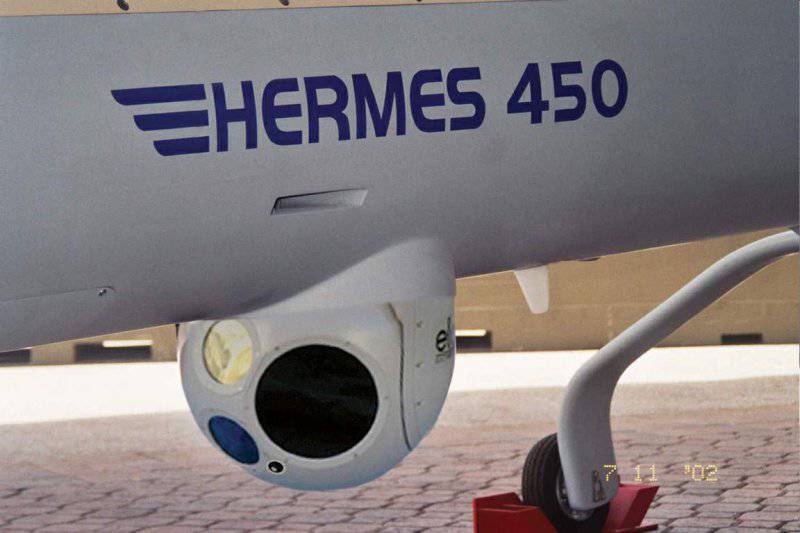
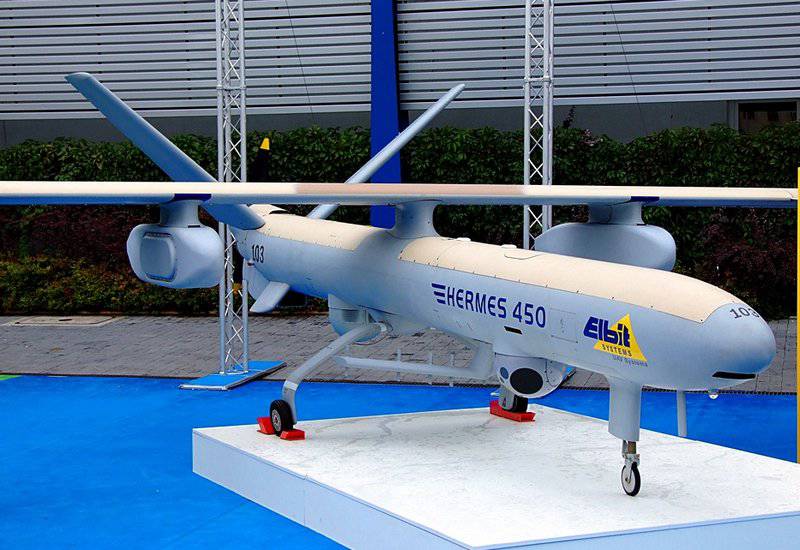
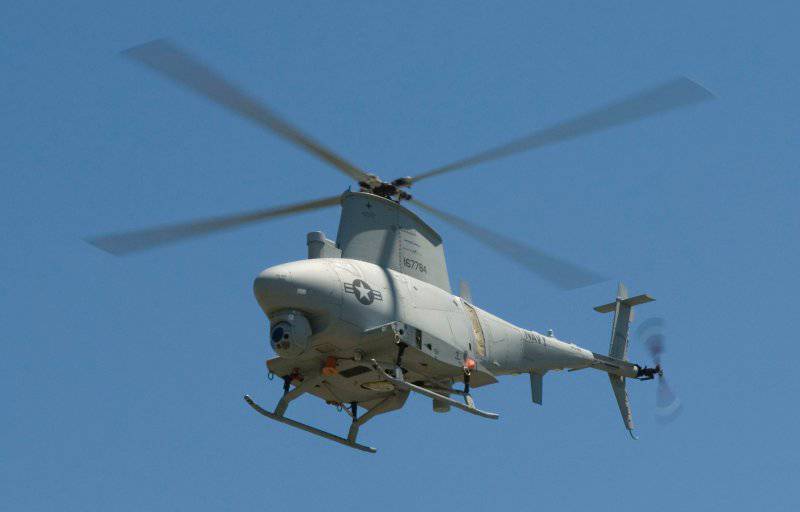
Information